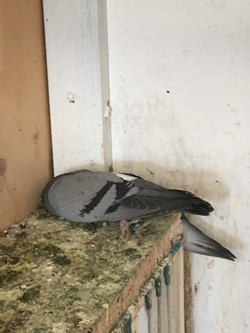Rotavirus mortalities of pigeons
From mid-2016 to late 2017, high levels of mortalities in captive pigeons (racing and fancy) occurred in lofts across Western Australia, Victoria, New South Wales and South Australia.
A rotavirus (a member of the Reoviridae family) was confirmed as the cause of the deaths. This was confirmed after ruling out other diseases including emergency animal diseases and notifiable diseases, namely avian influenza (AI), Newcastle disease (ND) and pigeon paramyxovirus virus type 1 (PPMV1).
Clinical signs
Clinical signs in birds infected with rotavirus include:
- depression, hunched postures
- vomiting/regurgitation
- diarrhoea.
Birds that appeared sick usually died within 12 to 24 hours, with deaths in affected lofts continuing for approximately 7 days (Figure 1). Mortality rates of up to approximately 30 per cent have been reported in affected lofts.

Diagnosis
Gross and histological findings include:
- severe necrotising hepatitis (friable when handled)
- coalescing hepatocyte degeneration and necrosis
- enlarged or pale spleens with severe depletion of lymphoid tissue
- reduction in the size of the cloacal bursa.
Laboratory analysis of liver tissue by PCR and histology have identified large quantities of virus of the Reoviridae family. This finding was confirmed by negative contrast electron microscopy. Next-generation gene sequencing on liver samples from affected pigeons confirms a rotavirus of serotype G18P.
During initial investigations, virus isolated from the liver of affected pigeons was inoculated into embryonated chicken eggs. Following the second passage, some pathology was evident. When samples of allantoic fluid were examined using negative-contrast electron microscopy, no virus was observed.
Susceptible species
Feral pigeons are likely to be susceptible to the virus. Any signs of disease that are unusual or clusters of deaths in wild birds should be reported.
In Western Australia, feral pigeon (rock pigeon – Columba livia) mortalities occurred in a location close to an affected loft, with gross and histological findings consistent with the disease in the racing and fancy pigeons. In addition, rotavirus had been detected in faecal samples of several feral and native wild bird species overseas.
The risk to the commercial poultry sector is considered low, based on field experience.
Biosecurity
Pigeon and squab owners are advised to implement biosecurity measures to prevent the spread of the disease. This includes reconsidering gatherings and movements (including racing) of pigeons, and practising good personal biosecurity and hygiene:
- Keep good hygiene:
- Clean/disinfect footwear, hands, and clothes after bird contact.
- Regularly remove faecal material from lofts and other housing. Keep lofts and equipment clean by using detergent-based cleaning chemicals.
- Have a final disinfection step of housing, transport, feeding and watering equipment after cleaning these surfaces first with detergent-based cleaning chemicals.
- Bird management:
- Quarantine new or returning birds for at least 2 weeks before introducing to the rest of the flock.
- Limit unnecessary visitors to where you keep your birds.
- Prevent contact with wild birds and droppings.
Vaccination
There is no indication that the PPMV1 vaccine is involved with this rotavirus disease.
An inactivated autogenous vaccine has been developed in Australia that can protect all pigeons.
Australia has a rigorous regulatory framework for assessing and approving veterinary vaccines to ensure their safety and efficacy. As part of this, there are strict penalties for the illegal importation and use of veterinary vaccines, including but not limited to up to 10 years imprisonment and fines of up to $1,800,000 under the Biosecurity Act 2015.
Reporting
It is important to continue to report any suspicious signs of disease. This will also allow the presence of notifiable diseases, including AI, PPMV1 and ND, to be investigated and ruled out.
There are three ways to notify Agriculture Victoria of notifiable diseases:
- Call the Emergency Animal Disease Hotline on 1800 675 888 (24 hours a day, every day of the year).
- The Notify Now app allows users to send high-quality geolocated photographs of the affected animals, with the owner’s details and property identification code.
- A completed Disease notification form can be emailed to cvo.victoria@agriculture.vic.gov.au
Image credits
Figure 1 provided by Dr C Walker.